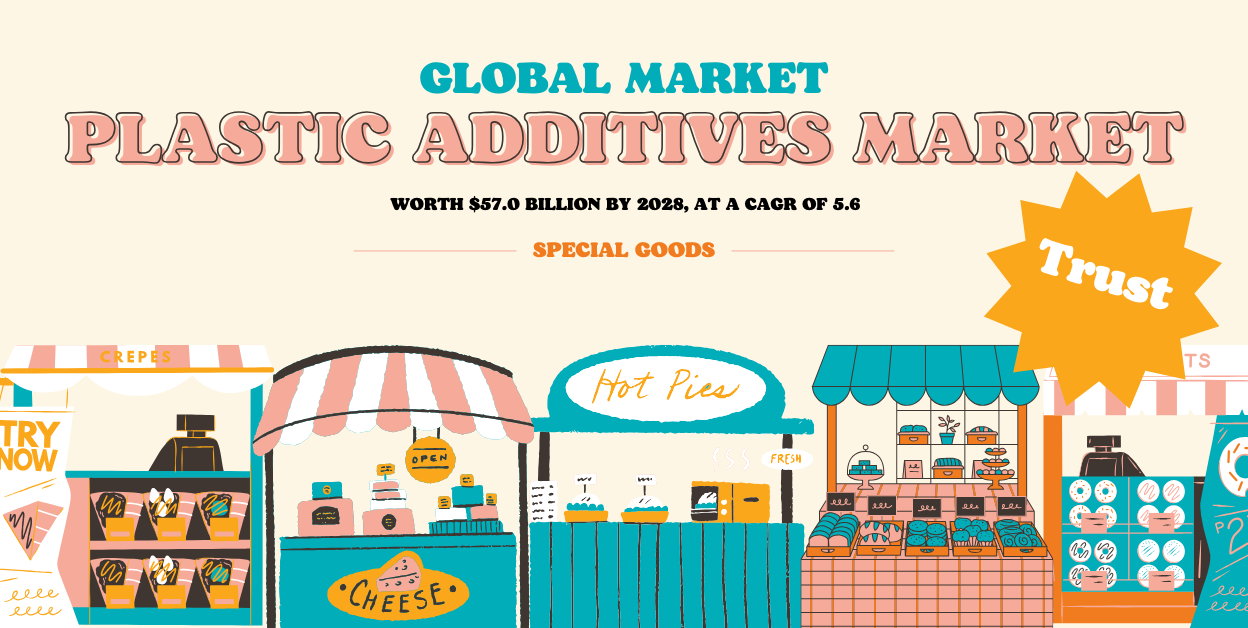The global plastic additives market is poised for significant growth, projected to reach a staggering $57.0 billion by 2028, fueled by a CAGR of 5.6% from 2023 onwards.
This expansion is driven by a confluence of factors, including the rising demand for plastics across diverse industries, continuous technological advancements in polymer science, and increasing regulatory requirements regarding safety and environmental impact.
What are Plastic Additives?
Plastics are ubiquitous in our modern world, used in everything from packaging and construction to consumer goods and electronics. This increasing demand translates to a growing need for plastic additives, essential for modifying and enhancing the properties of these versatile materials.
Read Also – Smart Agriculture Market – increasing to $29.2b at 9.7% CAGR by 2027
Key Drivers of the Plastic Additives Market
These additives improve mechanical strength, flexibility, thermal stability, color, flame retardancy, and other crucial characteristics, ensuring the performance and functionality of plastic products.
Several key drivers are propelling the growth of the plastic additives market. Expanding plastic demand, particularly in developing economies, is a major factor, as these regions witness rapid expansion in packaging, construction, and consumer goods sectors.
Additionally, technological advancements are paving the way for new and improved plastic additives with enhanced functionalities, catering to the evolving needs of various industries.
Furthermore, growing sustainability concerns among consumers are driving the development of eco-friendly plastic additives derived from sustainable sources or readily biodegradable materials.
The future of the plastic additives market promises exciting developments. Bio-based and biodegradable additives are gaining traction, aligned with the growing demand for sustainable solutions. We can also expect an increased focus on high-performance and specialty additives with enhanced functionalities.
Moreover, digitalization and automation will be crucial in optimizing production processes, improving supply chain efficiency, and paving the way for innovative plastic additive solutions.
See Also – Dollar General Corporation stock rises Wednesday, Dec 6 2023
Major Plastic Additive Types and Applications
The global plastic additives market can be distributed based on:
Type:
- Plasticizers: These additives increase the flexibility and workability of plastics. They are widely used in PVC films, cables, and flooring.
- Stabilizers: They protect plastics from degradation caused by heat, light, and other environmental factors. They are crucial for ensuring the long-term performance of various plastic products.
- Flame retardants: These additives reduce the flammability of plastics, enhancing fire safety in buildings, electronics, and other applications.
- Antioxidants: They prevent the oxidation of plastics, improving their resistance to degradation and discoloration.
- Fillers and reinforcements: These additives modify the physical properties of plastics, such as strength, stiffness, and density.
- Coloring agents: These additives provide color to plastics, enabling aesthetic customization and branding opportunities.
Application:
- Packaging: This is the largest application segment for plastic additives, driven by the growing demand for flexible packaging materials in food and beverage, pharmaceuticals, and other sectors.
- Construction: Plastic additives are used in various building materials, including pipes, profiles, and insulation, to improve their durability and performance.
- Automotive: Plastic additives play a vital role in lightweight vehicles and enhancing the performance of various automotive components.
- Consumer goods: These additives are used in a wide range of consumer products, such as toys, appliances, and electronics, to improve their aesthetics, functionality, and safety.
- Electrical & electronics: Plastic additives are crucial for ensuring the reliability and performance of electrical and electronic components.
Regional Landscape
The Asia Pacific region is expected to be the fastest-growing market for plastic additives, driven by its booming manufacturing sector and rapidly growing consumer base. Other key regional markets include North America, Europe, and Latin America.
Trends and Future Outlook
The future of the plastic additives market is expected to be shaped by several key trends:
- Growing demand for bio-based and biodegradable additives: Consumers are increasingly seeking sustainable solutions, leading to the development of additives derived from renewable or biodegradable resources.
- Focus on high-performance and specialty additives: The market will see an increase in demand for high-performance additives that enhance specific functionalities, such as flame retardancy, UV resistance, and antimicrobial properties.
- Digitalization and automation: The use of digital technologies will play a crucial role in optimizing production processes, improving supply chain efficiency, and developing innovative plastic additives.
Key Takeaways: The Plastic Additives Market
- Projected Market Size: $57.0 billion by 2028, growing at a CAGR of 5.6%
- Growth Drivers: Rising plastic demand, technological advancements, regulatory requirements, sustainability concerns
- Major Additive Types: Plasticizers, stabilizers, flame retardants, antioxidants, fillers, coloring agents
- Key Applications: Packaging, construction, automotive, consumer goods, electrical & electronics
- Fastest-growing Region: Asia Pacific
- Future Trends: Bio-based additives, high-performance additives, digitalization & automation
- Challenges: Fluctuating raw material prices, regulations, innovation needs
- Opportunities: Eco-friendly solutions, niche applications, customized additives
- Sustainability Focus: Bio-based and biodegradable additives, responsible use and disposal
Read more – Kinsmith Finance: A Trusted Provider of Personal Loans for Over 75 Years
FAQs about the Plastic Additives Market
The main drivers of the market are increasing demand for plastics, technological advancements, and regulatory requirements.
There are many different types of plastic additives, including plasticizers, stabilizers, flame retardants, antioxidants, fillers, and coloring agents.
The key trends in the market are the development of bio-based and biodegradable additives, high-performance additives, and digitalization & automation.
The challenges facing the market are fluctuating raw material prices, stringent regulations, and the need for continuous innovation.
The future opportunities for the market are the development of eco-friendly solutions, niche applications, and customized additives.
A: We can ensure a sustainable future for the plastic additives market by developing bio-based and biodegradable additives and promoting responsible use and disposal practices.
Conclusion
The global plastic additives market is a dynamic and thriving industry, driven by the growing demand for plastics across various sectors.
With increasing awareness of sustainability concerns and technological advancements, the market is expected to witness significant growth in the coming years.
This presents significant opportunities for manufacturers and players in the plastic additives industry to innovate, develop new solutions, and capitalize on the evolving market landscape.




